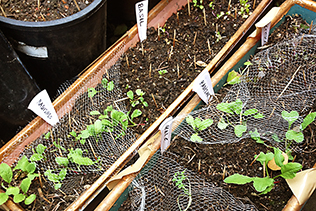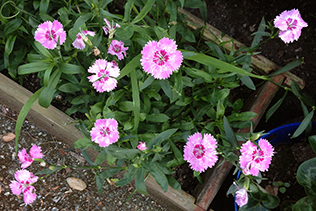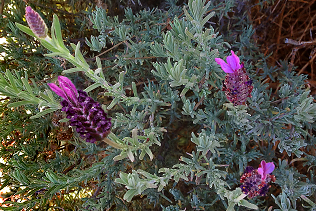"My green thumb came only as a result of the mistakes I made while learning to see things from the plant's point of view."
— H. Fred Ale
4/27/16:
Some of my recently planted seeds have become lovely little plants, growing quickly in the spring sun and responding well to organic fertilizer. Others, not so much. It looks like the main culprits in my garden are not snails and slugs at the moment, but insects and squirrels.
The best solution I have for insects so far is diluted coffee or garlic spray. It does get washed off with the slightest rain or even morning dew however.
Squirrels are cute and fun to watch. I enjoy having them around the yard. But I really wish they wouldn't dig holes to bury nuts in the lawn or in my planter boxes. Many lettuce seedlings have been damaged or dug out of the soil completely by squirrel paws. I found deterrent methods online; none that I tried were effective. I sprinkled the ground with cat fur and human hair trimmings, sprayed the plants with citrus oil or garlic, dusted the soil with chili powder, taped bits of fabric netting over the shorter plants, and stuck toothpicks in between the seedlings. I think a bit of wire fencing or clear plastic tenting are the next things to attempt. Hopefully I can come up with a solution that's inexpensive, easy to construct, doesn't look too ghetto, and is quickly removable so I can get into the area to water and weed.
Clicking on the small images below will bring up a larger version.

Ghetto squirrel deterrents.

Mild success at keeping pests
from chewing up the dianthus.

A cluster of bountiful blooms
on the tallest rosebush.
Another warm, dry growing season is being predicted for this region. Many local gardeners have concentrated on growing cacti and other succulents, which love the bright sun and don't require a lot of hydration. But my taste leans towards a "cottage garden" landscape, with rosebushes and other traditional flowers or herbs. So I've been reading up on blooming varieties that thrive in drier climates, and then using this knowledge to plan and plant this year. Not only will I be frugal with our household's water use, but selecting plants that are found naturally in similar environments makes a lot of sense for the ecosystem.
It's not surprising to find out that some of my hardy favorites, such as columbines and rosemary, have low water needs. Native plants that I bought last fall, red salvia and black sage, have also been smart choices that fit in nicely with the look of my container garden.
I have a few empty pots not allocated for transplanting tomatoes or peppers, so I explored the drought-tolerant section of Orchard Supply last weekend, eventually bringing home Santa Barbara daisies and lavender. I'll soon see how they fare with being transplanted. Both of these are known to attract butterflies and other pollinators, which is a nice bonus.

"Hot Lips" salvia.

Santa Barbara daisies.

Lavender.







